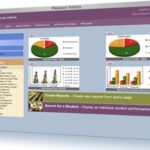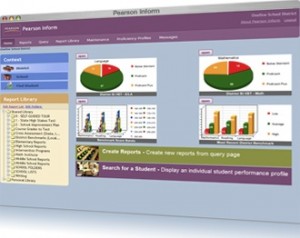
School data systems are getting more and more sophisticated, a perusal of exhibitors at the 2010 Florida Education Technology Conference (FETC) suggested—and at least two companies now offer systems that show teachers the entire history of their students’ test results, including the results from previous school years.
Pearson Inform is what Pearson School Systems is calling the latest version of its “performance analytics” software, which helps educators manage students’ achievement data. The software allows teachers to view a list of all assessments a given student has taken, even from prior academic years; by clicking on an assessment, teachers can see how the student did, what test items he or she got wrong, and what standards those test items correlate with.
A similar program from dataMetrics Software of Harvard, Mass., called TestWiz, also enables teachers to view historical information about their students’ test results.
“Wouldn’t it be nice if teachers got a class list in the fall, with the history of each kid already included?” said Naomi Menikoff, president of dataMetrics. Rather than operating blind at the start of the school year, she said, teachers instead would be able to target their instruction more effectively from the very first day of class.
TestWiz is a web-based test processing, scoring, and reporting tool with a robust SQL server database. It helps teachers and administrators track and analyze test data to make sure students are on the way to passing high-stakes exams.
The system has supported state assessments, DIBELS testing, and other standardized exams for more than a decade, but now it’s capable of managing local benchmarking tests as well, Menikoff said—such as formative assessments that teachers give throughout the year to check their students’ progress toward meeting state-mandated learning goals.
dataMetrics personnel will load test data into the system, or local users can scan or key this information in themselves, to create detailed profiles that can be viewed in several different ways: by student, class, or the entire school; by learning standard or instructor; and so on.
Users also can sort the data in many different ways. For example, they could quickly find those students who are not proficient in a given standard, or they could compare the results of a particular assessment with school, district, or statewide averages. In addition, users can export reports from the data as PDF or Word files, and they can create customizable letters to parents, complete with recommended interventions.
Like TestWiz, Pearson Inform also gives users a great deal of flexibility in viewing student data and creating reports; users can crunch the data by student, class, school, standard, and so on.
But Inform also can be purchased as part of a larger suite of software from Pearson, called Tapestry—an “umbrella for managing a school district’s digital assets and personalizing instruction,” the company says.
Pearson Tapestry combines the data management capabilities of Inform with assessment, course management, communication, and collaboration features. Using the combined software suite, teachers can create and deliver assessments electronically, collect results, track student progress toward mastery of learning goals, assign appropriate content to help students meet these goals, and communicate the results, Pearson said.
In other words, the software helps schools complete the full instructional cycle—all through a web-based portal with a single sign-on.
Pearson announced Tapestry at last year’s FETC, and the software was released to schools nationwide this past fall. In a demonstration for an eSchool News reporter, Pearson executives showed what the system is capable of.
When teachers report for the start of a new school year, they would see their class rosters in the system. For school districts using Pearson’s PowerSchool student information system (SIS), this information would flow seamlessly into Tapestry as soon as it’s entered into PowerSchool, but the software also works with any SIS that complies with the Schools Interoperability Framework (SIF), Pearson said.
To create an assessment, teachers would open Tapestry’s assessment management system, called Learnia, and use the software’s TestBuilder feature. Teachers can choose which item bank they want to use, and which standards they want the test to cover, and they’ll get a list of test questions to choose from. They can drag and drop test questions in whatever sequence they want to create their exam.
To assign the test, teachers would choose their class list and set an optional time limit for the exam, and the software then would administer the test to students. Once students are done taking the test, they can view the results instantly, allowing for immediate feedback—something that research shows is the most effective way for students to learn.
Teachers can view the assessment results by student, class, or even individual standard. These reports would include links to curricular resources that address each standard. Teachers then can assign these resources to individual students, so if a student has trouble with fractions, they could receive a link to a video or online tutorial covering this content area.
The software’s course management system is “content agnostic,” Pearson says—meaning teachers or curriculum coordinators can load content from almost any source and can tag it to the appropriate standards it addresses. Pearson also sells content bundles that can be loaded into the system as well.
- AI Educational Partnership to Elevate Classroom Presentations, Assessments - April 18, 2024
- SME Education Foundation Expands Manufacturing and Engineering Opportunities to 15K Additional Michigan Students - April 18, 2024
- Ozobot Launches Self-Service Professional Development Courses - April 17, 2024



Comments are closed.